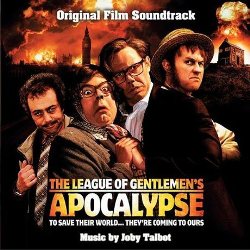THE LEAGUE OF GENTLEMEN’S APOCALYPSE – Joby Talbot
 Original Review by Jonathan Broxton
Original Review by Jonathan Broxton
Regular readers of Movie Music UK will know by now that I am a huge fan of the BBC TV series The League of Gentlemen, an unremittingly twisted comedy creation which follows the lives of the inhabitants of fictional English town of Royston Vasey. Having built up something of a cult following since its debut in 1999, it was to be expected that a cinematic spin-off would follow – and so we have The League of Gentlemen’s Apocalypse, a deliciously dark satire with hints of Hammer horror and even time travel! Directed by regular TV helmsman Steve Bendelack, Apocalypse begins when the inhabitants of Royston Vasey discover that they are fictional creations, dreamed up by the twisted imaginations of writers Mark Gatiss, Steve Pemberton and Reese Shearsmith.
The town is suffering an onslaught of apocalyptic proportions and so – to save the town – the characters have to travel from Royston Vasey into the real world. After the failure of “Team 1” – Edward (Shearsmith), Tubbs (Pemberton) and Papa Lazarou (Shearsmith again) – to contact the fourth member of the League, Jeremy Dyson (Michael Sheen), it falls to the unlikely Team 2 trio of psychotic butcher Hilary Briss (Gatiss), gay German teacher Herr Lipp (Pemberton) and manic-depressive Geoff Tipps (Shearsmith) to leave the safety of Royston Vasey and track down the real-life actors who play them (Gatiss, Pemberton and Shearsmith playing narcissistic versions of themselves). It seems that, instead of writing about the exploits of Royston Vasey, the League have been working on a new screenplay for a renaissance horror film called The King’s Evil – and this lack of interest has caused the town to self destruct! From then on, the anarchic humour kicks in, with everything from ejaculating giraffes to ancient magicians and men in toilets, as Team 2 try to convince the League to save their community.
Although the “characters becoming aware of their own fictitiousness” plot has been used countless times before, the way the League manage to twist it to their own unique vision makes this film a true delight. Having been criticised in the past for having too many one-joke one-dimensional characters, the writers used Apocalypse as an excuse to examine their creations in more detail, resulting in some surprisingly moving moments: Although the star of the show is undoubtedly Mark Gatiss, who turns in a truly monstrous and scary performance as Hilary Briss, it is Herr Lipp’s realisation of his true nature, and his rail against Steve Pemberton, which provide the best dramatic moments. The scenes with Lipp pretending to be Pemberton (complete with a mixed Blackburn/Duisburg accent) are as funny as they are affecting, and bring a wonderful new facet to the character. Film buffs will love the multitude of cinematic references the League pack into their movie, especially the wonderfully retro Ray Harryhausen-style stop motion animation, and British cameo-spotters will have a ball picking out the likes of Victoria Wood, Peter Kay and Simon Pegg from the cast.
Musically, The League of Gentlemen was always excellent, and Apocalypse continues the trend, giving composer Joby Talbot the opportunity to broaden the scope of his TV music with a bigger orchestra and more money. The familiar jazzy main theme is still prominent, but goes through a number of interesting permutations, from bittersweet to action-styled, even being heard as a mobile phone ring tone! During several key scenes Talbot is given the opportunity to pastiche the sound of Bach and Handel with a series of beautiful harpsichord-led baroque pieces for the sequence set in the Renaissance royal court, while at other times his music is shamelessly based on the classic Hammer horror scores of James Bernard and others, of whom Talbot is a great admirer. There is also a great deal of action music, most notably during Hilary’s fight with the Humunculus, and the glorious theme which first appeared at the end of Season 3 (“While There’s Still Time”) is reworked into an amazing orchestral ‘catharsis’ theme for the film’s finale.
The opening cue sees the League’s main theme set to a nervously ticking, John Carpenter-esque rhythm and gradually builds to a grand and gothic rendition of that three-note theme. The cue effectively sets the tone for what’s to follow. “Little Brown Fish” is a wonderfully dramatic action set piece, comprising mostly of rising and falling motifs that have become a trademark for the composer. The cue goes through a series of rousing arpeggios until a deliciously gothic motif signals the demise of Jeremy Dyson, the often forgotten fourth member of the League.
“Leaving for London” is the score’s weakest link as the theme is presented in a funky, urban arrangement. Unfortunately, the melody doesn’t really lend itself for such a treatment. The orchestra is back in full force in “Meteors”, with harp and piano providing a clock-like rhythm, and the strings and woodwinds creating a mysterious atmosphere as Royston Vasey is being struck by giant fireballs falling from the sky. “Pig Funeral” is the first of several baroque inspired cues, complete with Talbot playing the harpsichord. “The King’s Evil” and “Arise Sir Geoffrey” are two further tracks that are written for this particular instrument, with the latter resembling Michael Nyman particular – not surprising as Talbot was a pupil of his, and this fact is what landed him the job to score the League’s television series in the first place.
“Storm over Royston Vasey” is made up of see-sawing motifs, but doesn’t offer a theme as such. It works purely as underscore, as does “Into the Crypt”, although the latter does contain an enjoyable mysterious atmosphere. “Stripped Down Theme” is a rendition of the League’s main theme for bass, percussion and jazzy vocals; and sounds more like Talbot’s work on the television series than the rest of the film’s score. Big percussion and a relentless arpeggio form the basis of the modern sounding action cue “Have You Seen Me?”, while “Dr Pea” contains old Hammer Horror-like brass sounds to introduce the ‘main baddie in this piece’.
Three of the score’s highlights are “An Humunculus”, “Back in Royston Vasey” and “Hilary Versus the Humunculus”, with their Ray Harryhausen-type monster music, and with pulsating arpeggios, dramatic chords and cymbal swooshes in abundance. The latter cue contains a satisfyingly heroic version of the main theme as Hilary indeed defeats the three-headed homunculus.
“Herr Lipp in the Attic” accompanies our German protagonist snooping around in the attic and briefly presents the film’s happy-ending theme, as heard later on in “It’s a Miracle”, when Lipp finds some articles about himself. The cue turns more sinister, however, when these articles turn out to be rather dismissive of the German English teacher. Things turn even nastier in the unremitting action piece “Herr Lipp Unmasked”, with its fat brasses and frantic woodwind stingers. The album ends with the film’s gorgeously sweeping end title music, which is an orchestral treatment of the piano theme that accompanied the finale of the third TV series. It’s a wonderfully melancholy tune that sounds both happy and sad at the same time, and sounds quite original through its unusual syncopated rhythm.
Talbot’s music for the television series has always been exceptionally good, and the film is no exception. It also further establishes his recognizable style that is made up from rhythmic patterns rather than lush melodies, with the occasional exception such as “End Titles”; and fans of Talbot’s music for The Hitchhiker’s Guide to the Galaxy will find much to enjoy on Apocalypse as the music is written in exactly the same idiom. Apocalypse also showcases his clear, transparent orchestrations, although kudos also goes to Christopher Austin, Andrew Skeet, Ben Foster and Gary Carpenter. The performance by the RTE Concert Orchestra is more than adequate though, in all fairness, not top notch. However, the fun in writing and performing this music shines through in every single track, making nitpicking over tiny little errors pointless. Silva’s packaging is nicely done with liner notes from the composer, and with additional notes containing the film’s synopsis. Besides, any CD that has a close up picture of Papa Lazarou on the inside is worth every penny! Finally, as a bonus, music by Crème Brulee is not featured on this album. If you don’t know what we’re on about… it’s high time you start checking out the show.
Rating: ****
Track Listing:
- Apocalypse Theme (1:47)
- Little Brown Fish (3:45)
- Leaving For London (1:03)
- Meteors (2:25)
- Pig Funeral (0:52)
- Storm Over Royston Vasey (1:21)
- Stripped Down Theme (0:57)
- Have You Seen Me? (1:33)
- Dr Pea (2:00)
- Into the Crypt (1:21)
- An Humunculus (4:30)
- King’s Evil (1:55)
- Herr Lipp in the Attic (1:32)
- Herr Lipp Unmasked (2:21)
- Arise Sir Jeffrey (1:19)
- Back in Royston Vasey (3:54)
- Hilary Versus the Humunculus (3:09)
- It’s A Miracle (3:02)
- End Titles (3:26)
Running Time: 42 minutes 21 seconds
Silva Screen SILCD1189 (2005)
Music composed by Joby Talbot. Conducted by Christopher Austin. Performed by The RTE Concert Orchestra. Orchestrations by Christopher Austin, Andrew Skeet, Ben Foster and Gary Carpenter. Featured musical soloists Rob Farrer and Joby Talbot. Recorded and mixed by Mark Wyllie. Mastered by Rick Clark. Album produced by Joby Talbot.

